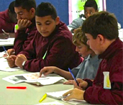Years 7–10 Syllabuses
Schools in New South Wales use the Years 7–10 syllabuses listed below. Click a syllabus to view it in full.
The NSW K–10 English, Mathematics, Science (including Science and Technology K–6) and History syllabuses are available in an interactive format via the NSW syllabuses site. The online presentation allows filtering, searching and viewing by stage and subject. There are a range of materials available to support implementation of the syllabuses including sample scope and sequences, units and assessment activities.
The information for English, Mathematics, Science and History in the Years 7–10 Syllabus Course Descriptions has been updated to reflect the requirements and content of the new syllabuses.
Information about other syllabuses in the Years 7–10 Syllabus Course Descriptions is unchanged.
All schools are required to deliver programs of study that comply with the requirements of NESA syllabuses. For schools that are accredited the courses must also satisfy the prescribed hours for the Record of School Achievement and be based on the outcomes of NESA syllabuses.
Beyond the prescribed study hours schools have discretion to offer courses beyond the NESA curriculum. If individual schools choose to teach material not approved or endorsed by NESA, it must be made clear to students that this material is additional to and not part of the relevant NESA syllabus. Such material is not to be set as part of school-based assessment of NESA syllabuses that contributes to the Record of School Achievement.
The teaching of any religious, ideological or philosophical beliefs that are not in conflict with these constraints and are not otherwise contrary to the requirements of the Education Act is a matter for the school and the school community.
Contact: KLA Inspector
Ph: +61 2 9367 8111
English
Mathematics
Science
Creative Arts
- Dance
- Drama
- Music
- Photographic and Digital Media
- Visual Arts
- Visual Design
HSIE (Human Society and Its Environment)
- Aboriginal Studies
- Commerce
- Geography
- Geography Elective
- History
- History Elective
- Work Education
Languages
- Aboriginal Languages
- Arabic
- Chinese
- Classical Greek
- French
- German
- Hebrew
- Indonesian
- Italian
- Japanese
- Korean
- Latin
- Modern Greek
- Russian
- Spanish
- Turkish
- Vietnamese
PDHPE
- Child Studies (Content Endorsed Course)
- Personal Development, Health and Physical Education (PDHPE)
- Physical Activity and Sports Studies (Content Endorsed Course)
TAS (Technological and Applied Studies)
- Agricultural Technology
- Design and Technology
- Food Technology
- Graphics Technology
- Industrial Technology
- Information and Software Technology
- Marine and Aquaculture Technology (Content Endorsed Course)
- Technology (Mandatory)
- Textiles Technology
VET in Years 9 and 10 (Stage 5)
Information about studying a Vocational Education and Training (VET) course in Stage 5 can be found in the VET section.
School Developed Board Endorsed Courses – Guidelines for Course Proposals
Equivalent and Alternative Courses of Study
Organisations and students seeking to deliver or undertake equivalent or alternative courses of study can find guidelines, application forms and further information on the Equivalent and Alternative Courses of Study page on the new NESA site.
The Common Grade Scale
The A-E grading scale lets teachers report student academic achievement at any point in time using clear standards. Teachers will make a professional on-balance judgement as to which grade best matches the standard their students have achieved.
Years 7–10 Syllabus Course Descriptions
PDF (38 pages, 233 KB)
Word (38 pages, 270 KB)
Updated February 2014
Syllabus feedback

An important part of the NESA continuous improvement program is feedback from teachers, students and other interested people. To give your view on syllabus and other curriculum matters, complete the Syllabus Feedback Form.

- Need help with downloading and viewing?
- You can also convert PDF documents into alternative formats.

 NSW Government
NSW Government